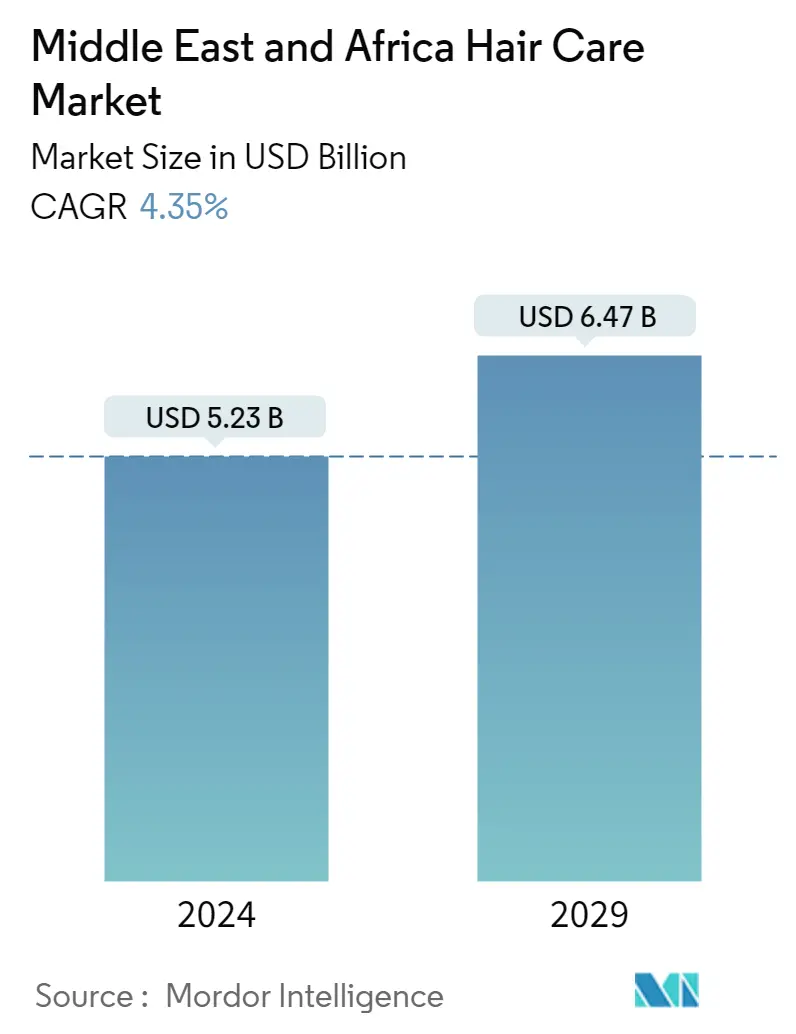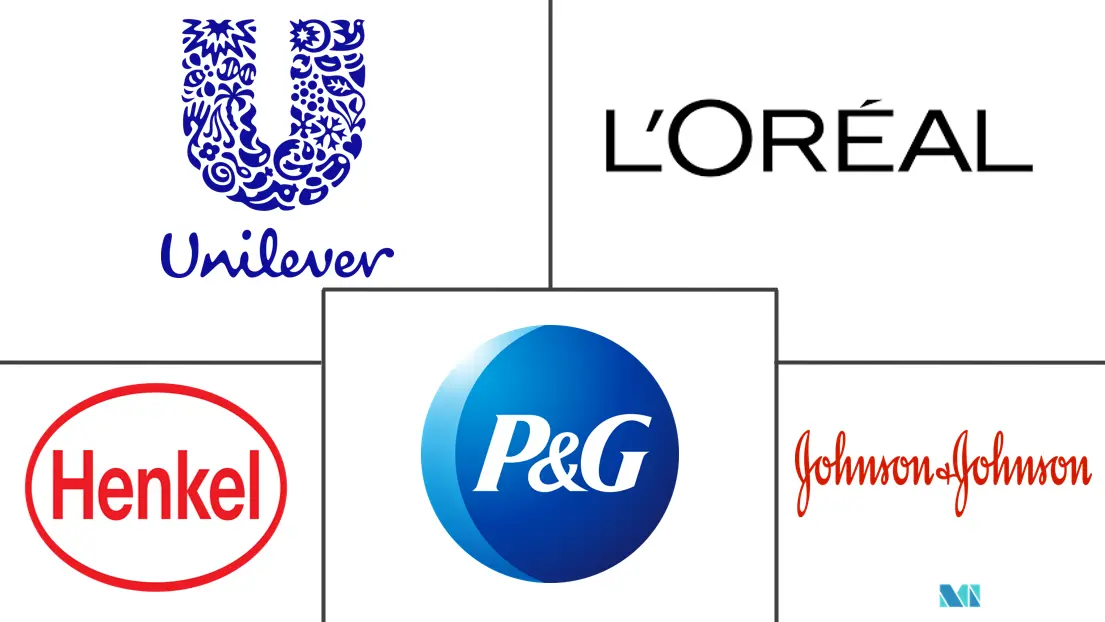Market Size of Middle East & Africa Hair Care Industry

| Study Period | 2019 - 2029 |
| Base Year For Estimation | 2023 |
| Market Size (2024) | USD 5.23 Billion |
| Market Size (2029) | USD 6.47 Billion |
| CAGR (2024 - 2029) | 4.35 % |
| Market Concentration | Low |
Major Players
*Disclaimer: Major Players sorted in no particular order |
MEA Hair Care Market Analysis
The Middle East & Africa Hair Care Market size is estimated at USD 5.23 billion in 2024, and is expected to reach USD 6.47 billion by 2029, growing at a CAGR of 4.35% during the forecast period (2024-2029).
- Some of the main concerns that everyone experiences include dandruff, dry and itchy scalp, hair loss, and dull hair. One of the most typical problems affecting the hair and scalp is dandruff. Customers widely use anti-dandruff shampoos to cure dandruff. As pyrithione zinc has anti-fungal properties, it is frequently used in anti-dandruff shampoos. Natural components, including tea tree oils, neem, basil, rosemary, lemon, and cedarwood, are becoming increasingly popular in anti-dandruff shampoos.
- In the meantime, the Middle Eastern region witnessed an increasing demand for natural and organic products due to the rise in consumer awareness about the harmful effects of certain compounds, such as paraben and aluminum compounds, present in hair care products. This has increased the demand for safe, natural, and organic shampoos, conditioners, hair oils, and hair masks, among others, in recent times. The purchases are based on the product's efficacy, long-lasting protection, and clinical properties.
- The demand for hair care products in the Middle Eastern region is mainly due to an increase in the young and aspirational populations who invest in grooming and appearance, primarily in maintaining their health. One of the key trends in the market includes hair care products that comply with the halal law, which is also becoming a global trend.
- Moreover, Gulf consumers prefer personalized products and services, further bolstering the market's growth studied by catalyzing the private-label and indigenous manufacturers to cater to this gap in the hair care industry and secure a position for themselves in the highly fragmented and intensely competitive industry.
MEA Hair Care Industry Segmentation
Haircare refers to the practices and products used to maintain the health, cleanliness, and appearance of hair. This can include various activities such as washing, conditioning, brushing, styling, and treating hair with various products. The goal of haircare is to keep hair healthy, strong, and looking its best.
The Middle East & African haircare market is segmented by type, distribution channel, and country. Based on product type, the market is segmented into shampoo, conditioner, hair loss treatment products, hair colorants, hair styling products, and other product types. By distribution channel, the market is segmented into supermarkets/hypermarkets, convenience/grocery stores, specialty stores, pharmacies/drug stores, online channels, and other distribution channels. By geography, the market covers economies such as South Africa, the United Arab Emirates, Saudi Arabia, and the Rest of Middle East & Africa.
For each segment, the market sizing and forecasts have been done in value terms of USD million.
| Type | |
| Shampoo | |
| Conditioner | |
| Hair Loss Treatment Products | |
| Hair Colorants | |
| Hair Styling Products | |
| Other Types |
| Distribution Channel | |
| Hypermarkets/Supermarkets | |
| Convenience/Grocery Stores | |
| Specialty Stores | |
| Pharmacies/ Drug Stores | |
| Online Channels | |
| Other Distribution Channels |
| Country | |
| Saudi Arabia | |
| United Arab Emirates | |
| South Africa | |
| Rest of Middle East & Africa |
Middle East & Africa Hair Care Market Size Summary
The Middle East and Africa hair care market is experiencing a notable expansion, driven by a growing awareness of personal grooming and the increasing demand for natural and organic products. Consumers in the region are becoming more conscious of the ingredients in their hair care products, leading to a rise in the popularity of products free from harmful compounds like parabens and aluminum. This shift is particularly evident in the demand for anti-dandruff shampoos and other hair care solutions that incorporate natural ingredients such as tea tree oil, neem, and rosemary. The market is also witnessing a trend towards products that comply with halal standards, reflecting the cultural preferences of the region's consumers. The young and aspirational demographic is a significant driver of market growth, as they prioritize grooming and appearance, further fueled by the convenience and accessibility of e-commerce platforms.
In Africa, the hair care market is influenced by factors such as urbanization, changing lifestyles, and the need to address specific hair concerns like traction alopecia. The introduction of innovative products, such as natural and organic shampoos and conditioners, is helping manufacturers cater to the unique needs of African consumers while minimizing environmental impact. The market is also seeing increased activity from foreign players who are introducing professional home care products to meet the demand for hair loss treatments and color protection. Social media marketing and influencer partnerships are playing a crucial role in attracting younger consumers, with celebrities promoting hair care brands. The competitive landscape is marked by the presence of multinational companies like L'Oreal, Procter & Gamble, and Unilever, which are expanding their regional footprint through online marketing and new product developments.
Middle East & Africa Hair Care Market Size - Table of Contents
-
1. MARKET DYNAMICS
-
1.1 Market Drivers
-
1.2 Market Restraints
-
1.3 Industry Attractiveness - Porter's Five Forces Analysis
-
1.3.1 Threat of New Entrants
-
1.3.2 Bargaining Power of Buyers/Consumers
-
1.3.3 Bargaining Power of Suppliers
-
1.3.4 Threat of Substitute Products
-
1.3.5 Intensity of Competitive Rivalry
-
-
-
2. MARKET SEGMENTATION
-
2.1 Type
-
2.1.1 Shampoo
-
2.1.2 Conditioner
-
2.1.3 Hair Loss Treatment Products
-
2.1.4 Hair Colorants
-
2.1.5 Hair Styling Products
-
2.1.6 Other Types
-
-
2.2 Distribution Channel
-
2.2.1 Hypermarkets/Supermarkets
-
2.2.2 Convenience/Grocery Stores
-
2.2.3 Specialty Stores
-
2.2.4 Pharmacies/ Drug Stores
-
2.2.5 Online Channels
-
2.2.6 Other Distribution Channels
-
-
2.3 Country
-
2.3.1 Saudi Arabia
-
2.3.2 United Arab Emirates
-
2.3.3 South Africa
-
2.3.4 Rest of Middle East & Africa
-
-
Middle East & Africa Hair Care Market Size FAQs
How big is the Middle East & Africa Hair Care Market?
The Middle East & Africa Hair Care Market size is expected to reach USD 5.23 billion in 2024 and grow at a CAGR of 4.35% to reach USD 6.47 billion by 2029.
What is the current Middle East & Africa Hair Care Market size?
In 2024, the Middle East & Africa Hair Care Market size is expected to reach USD 5.23 billion.

